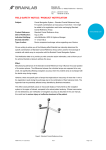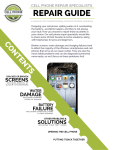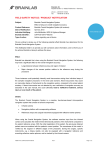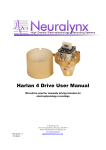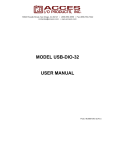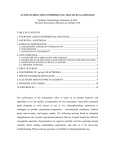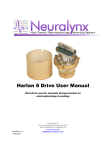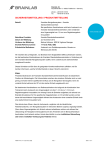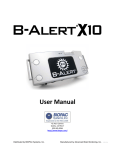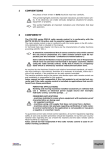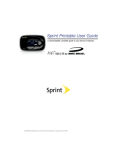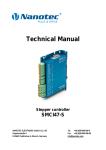Download Field Safet Notice / Product Notification
Transcript
FIELD SAFETY NOTICE / PRODUCT NOTIFICATION Subject: Cranial Navigation System – Standard Cranial Reference Array: For specific combinations an inaccuracy of up to 1.5 mm might be added to the registration result when exchanging Standard Cranial Reference Arrays Product Reference: Standard Cranial Reference Array Date of Notification: November 22, 2012 Individual Notifying: Markus Hofmann, MDR & Vigilance Manager Brainlab Identifier: 11-12-22.TGE.2 (IIB) Type of action: Device component exchange; advice regarding use of device We are writing to advise you of the following effect Brainlab has internally determined for specific combinations of Standard Cranial Reference Arrays when used for the exchange of unsterile with sterile array in conjunction with the Brainlab Cranial Navigation System. This Notification letter is to provide you with corrective action information, and to inform you of the actions Brainlab is taking to address this issue. Effect: Manufacturing tolerances of the Standard Cranial Reference Array influence the actual position of its marker spheres. The differences between the individual arrays are supposed to be very small, not significantly affecting navigation accuracy when the unsterile array is exchanged with the sterile array during surgery. However, there are specific combinations of arrays that might add an inaccuracy of more than 1 mm, up to 1.5 mm, to the registration result during the exchange due to the combination of their tolerance limits. The Appendix B lists the arrays identified by Brainlab simulations for your specific user site that might add the described inaccuracy during the exchange of unsterile with sterile array. This effect could potentially cause an inaccurate display of instruments by the navigation system in the region of interest, compared to the actual patient anatomy. If these inaccuracies would add up to be clinically relevant and would not be detected by user verification of navigation accuracy as described in the user manual, this could ultimately lead to ineffective treatment or serious injury of the patient. Figure 1: Standard Cranial Reference Array FORM 14-04, 11-12-22.TGE.2 (IIB) Rev 7 Page 1 of 7 Details: Reference arrays, e.g. the Standard Cranial Reference Array, allow the navigation system to track the location of the patient’s anatomy throughout the procedure. Usually, two reference arrays are used: • One for preoperative procedures (patient registration). The reference array used for registration may be unsterile as registration is usually performed in an unsterile environment. • One for intraoperative navigation. The reference array used for navigation must be sterilized before use and attached during draping. After the successful registration of the patient using the Brainlab navigation software it is required to carefully remove the unsterile reference array, drape the patient and then attach the sterile reference array. With this exchange an inaccuracy of up to 1.5 mm might be added to the registration result if array pairs with specific combinations of tolerance limits are used. User Corrective Action: According to our records you are the owner of one or several of the potentially affected Standard Cranial Reference Arrays. Please refer to the Appendix B for the specific serial numbers defined for your site that might add the described inaccuracy in combination with another array available at your site during the exchange of unsterile with sterile array. Please note that the article 41730A REFERENCE CLAMP UNIVERSAL (WITH 2 ARRAYS) contains two reference arrays bearing the same serial number. In contrary to the defined and listed reference arrays, the clamp itself also contained in this article remains unaffected. Until you have been provided with a replacement for the in Appendix B defined affected arrays available at your site, always closely adhere to the attached additional instructions in Appendix A for every surgery using the Brainlab Cranial Navigation system. Brainlab Corrective Action: 1. Existing potentially affected customers who own one or several of the defined Standard Cranial Reference Arrays receive this product notification letter. 2. Brainlab actively replaces the defined affected Standard Cranial Reference Arrays existing at specific user sites to improve exchange compatibility. Tentatively planned completion: by June 2013. Please advise the appropriate personnel working in your department of the content of this letter. FORM 14-04, 11-12-22.TGE.2 (IIB) Rev 7 Page 2 of 7 We sincerely apologize for any inconvenience and thank you in advance for your co-operation. If you require further clarification, please feel free to contact your local Brainlab Customer Support Representative. Customer Hotline: +49 89 99 15 68 44 or +1 800 597 5911 (for US customers) or by E-mail: [email protected]. Fax Brainlab AG: + 49 89 99 15 68 33 Address: Brainlab AG (headquarters), Kapellenstrasse 12, 85622 Feldkirchen, Germany. November 22, 2012 Kind Regards, Markus Hofmann MDR & Vigilance Manager [email protected] Europe: The undersign confirms that this notice has been notified to the appropriate Regulatory Agency in Europe. Attachments: - Appendix A: Additional instructions. - Appendix B: Specific serial numbers of affected Standard Cranial Reference Arrays defined for your site. FORM 14-04, 11-12-22.TGE.2 (IIB) Rev 7 Page 3 of 7 Appendix A: Additional instructions 1) Perform an inventory of the Standard Cranial Reference Arrays available at your user site: Serial number Article number Figure 2 – Where to find the Serial Number on the Standard Cranial Reference Array Identify the manufacturing dates: You can read the year of production from the serial number as follows: 45687 09 001 or 45687- 09 -001 09 indicates manufacturing in 2009 Usage frequency and age of the array strongly influence the product quality and navigation accuracy. Therefore arrays with newer manufacturing dates should always be preferred for usage. Brainlab therefore strongly recommends in general to no longer use arrays that are older than 5 years. Please remove arrays with manufacturing date before 2007 from your inventory and clinical use if you would have such old arrays available. These old arrays can be identified by a lower number than ‘07’ within the Serial number as illustrated in Figure 2 above. Identify the specific serial numbers defined for your site that might add the described inaccuracy during the exchange of unsterile with sterile array. Please refer to Appendix B for these arrays identified for your specific site. Preferably, if available at your site, use only the remaining (not listed) arrays at your site manufactured no longer than 5 years ago, i.e. manufacturing earliest 2007 or later (please see serial number). In that case, preferably remove the arrays with the Serial Numbers defined in Appendix B from clinical use. Alternatively, if no sufficient amount of Standard Cranial Reference Arrays manufactured in 2007 or later remains available, for continued use of the defined arrays in Appendix B, closely adhere to the following instructions for every surgery using the Brainlab Cranial Navigation system. FORM 14-04, 11-12-22.TGE.2 (IIB) Rev 7 Page 4 of 7 2) The following instructions aim at helping you to detect and resolve an additional error that might be introduced by the defined arrays at your site when exchanging the unsterile reference array with the sterile reference array after registering the patient. At a distance of 30 cm from the reference array, the additional error introduced could be up to 1.5mm. Do not attempt to avoid exchanging the reference array by draping the unsterile reference array. Draping a tracking geometry will introduce bigger inaccuracies than the inaccuracy caused by replacing the array. These instructions are only applicable when using the standard cranial reference array. They are not applicable when using the headband or skull reference arrays. • Reference array position The closer to the actual region of interest the array is mounted, the less the described effect influences navigation accuracy in the region of interest. Choose a position of the reference array as close to the region of interest as possible, without the array interfering with the necessary surgical space. • Patient Registration Perform patient registration and verification according to the corresponding Software User Guide. After successful patient registration and careful verification of registration accuracy, perform the following additional action: • Landmark definition Select as many anatomic landmarks as possible that are accessible and precisely identifiable throughout the surgery. In order to estimate the additional error introduced by replacing the array, it is sufficient if at least one landmark is available on the contralateral side of the reference array (i.e. further away from the reference array than your region of interest). In order to make an overall intra-operative accuracy check of the registration, at least three landmarks should be available. Example anatomical landmarks are: Canthus lateralis, nasion, inion, tragus, entry of the outer ear canal or bregma. It is recommended to mark all landmarks with a pen on the patient’s skin so that they can be located easily during surgery. Alternatively, if no landmarks are accessible, it is also possible to use a point that stays in a fixed relation to the standard cranial reference array in your patient setup (such as a divot on the headclamp) or an artificial landmark by placing a bone screw. • Landmark acquisition When marking a landmark with a pen, acquire it as a point by placing the instrument tip on the desired point and pressing the “Acquire” button in the navigation software. Button in minimized view Button in maximized view Figure 3 – Buttons in the navigation software to acquire landmarks The software will now display the deviation between the pointer position and the position of the acquired landmark if the distance is lower than 8 mm. Acquire all chosen anatomic landmarks(at least 3) in the navigation software. FORM 14-04, 11-12-22.TGE.2 (IIB) Rev 7 Page 5 of 7 • Exchange of reference arrays and draping Now remove the unsterile reference array and drape the patient. Choose a transparent drape in the area where your landmarks are located, either an adhesive incision drape or a standard clear plastic drape. Attach the sterile reference array according to the user guide. • Landmark verification Use the sterile pointer to access the previously acquired landmarks. The software will now display the deviation measured at each landmark. Make sure that the displayed deviation is lower than you require for surgery. Figure 4 – Example of navigation software displaying distance of pointer tip to landmark For additional information regarding registration procedures, consult the respective chapters in the software user guide. Ensure that the necessary accuracy is achieved before basing any clinical decisions on the information provided by the Brainlab Navigation system. FORM 14-04, 11-12-22.TGE.2 (IIB) Rev 7 Page 6 of 7 3) General Reminder: Continue to follow the available instructions in the relevant user manuals. The Brainlab Cranial / ENT system solely provides assistance to the surgeon and does not substitute or re-place the surgeon’s experience and/or responsibility during its use. • The Brainlab Cranial/ENT instruments are highly accurate and sensitive medical devices and must be handled with extreme care. If you drop or otherwise damage an instrument, return it immediately to Brainlab for testing. Failure to do so may lead to serious injury to the patient. • Do not use damaged instruments. • Ensure that the position of the headholder adapter does not change when attaching the sterile reference array. This could result in inaccurate navigation and ultimately in serious patient injury. • Verify registration accuracy after exchanging the unsterile reference array for the sterile reference array. • Ensure that the reference array does not move relative to the patient’s anatomy during the procedure. Changing the array’s position directly influences the navigation coordinate system. This could result in inaccurate navigation and ultimately in serious patient injury. • To avoid unintentional movement of the reference array, do not place pressure on it. • If the position of the reference array changes relative to the patient, a new registration is required. • A new registration is required if the patient was repositioned after registration. • Check regularly that the marker spheres remain tightly screwed onto the pins. • Navigation accuracy critically depends on the condition of the marker spheres used. • Verify prior to use that the reflective surface of all marker spheres is in good condition, and not peeling. FORM 14-04, 11-12-22.TGE.2 (IIB) Rev 7 Page 7 of 7 Appendix B Below is a list of the specific serial number(s) of the Standard Cranial Reference Array identified for your site, that might add the described inaccuracy of up to 1.5 mm during the exchange of unsterile with sterile array. Serial number Article number Figure 2– Where to find the Serial Number on the Standard Cranial Reference Array Site Name: <Hospital> Serial Number (affected arrays): Amount of Arrays with this Serial Number: XXXXXXXXXX # XXXXXXXXXX # XXXXXXXXXX # Appendix B to FORM 14-04, 11-12-22.TGE.2 (IIB) Rev 7 Page 1 of 1








